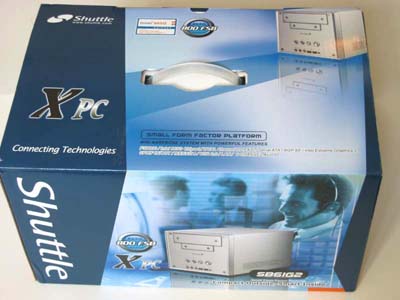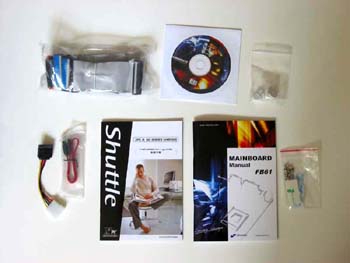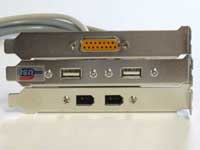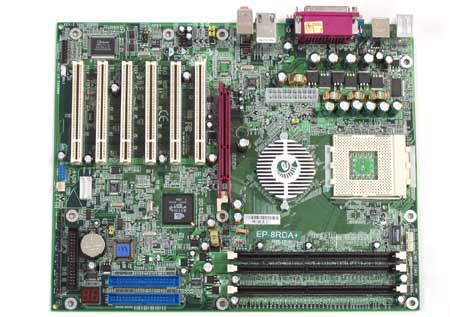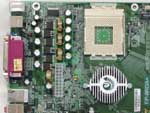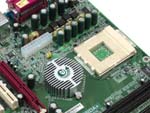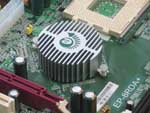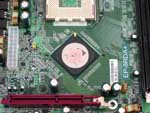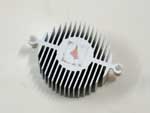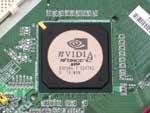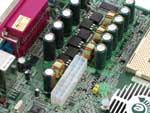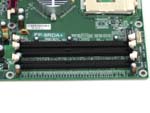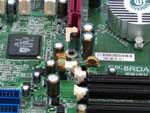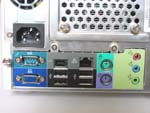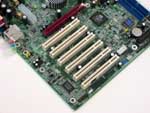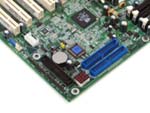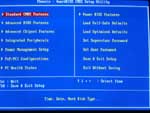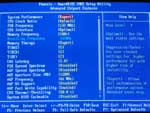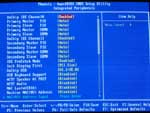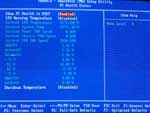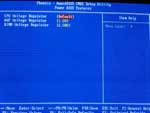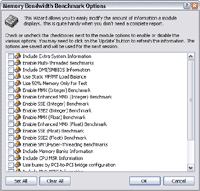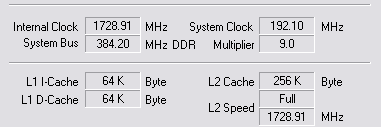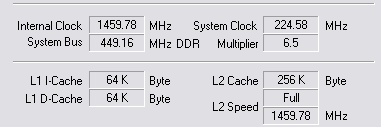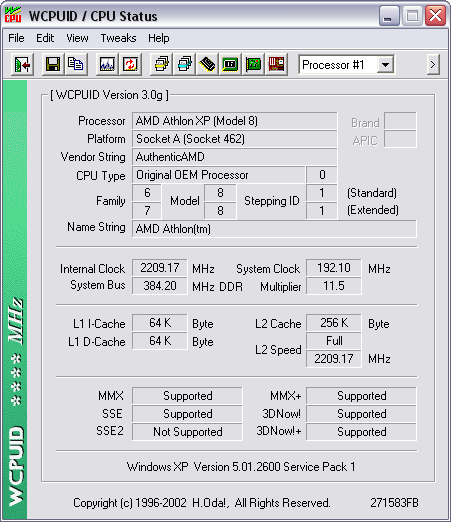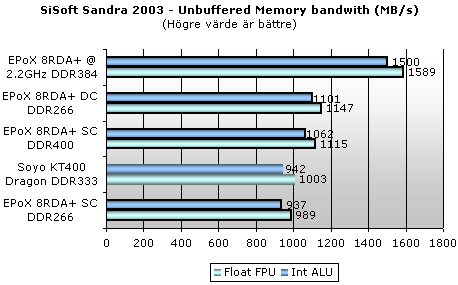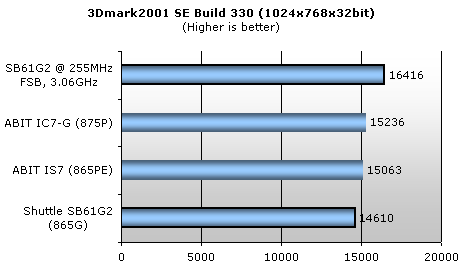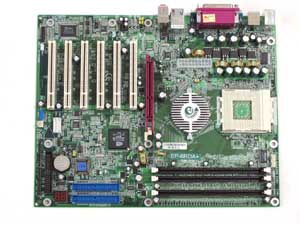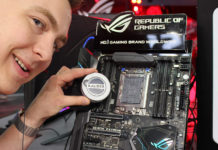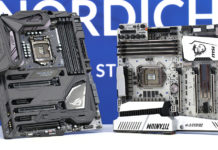NVidia is a name you directly relate to video cards and has been so for quite a while. The company has been dominating the graphics market ever since 3Dfx expired but during the latest months nVidia has shown up more and more in another context. The nVidia’s follow-up of the promising nForce-chip has proven to be very popular and we have seen the great performance of the nForce2-chip here in our test lab. Even if nVidia does not have the same influence on the motherboard market as it has on the video card market the majority of all motherboard manufacturers introduced a motherboard based on the nForce2-chip.
NVidia is a name
you directly relate to video cards and has been so for quite a while. The
company has been dominating the video market ever since 3Dfx expired but
during the latest months nVidia has shown up more and more in another context.
The nVidia’s follow-up of the promising nForce-chip has proven to be very
popular and we have seen the great performance of the nForce2-chip here in
our test lab. Even if nVidia does not have the same influence on the motherboard
market as it has on the video card market the majority of all motherboard
manufacturers introduced a motherboard based on the nForce2-chip.
The first of it’s kind we looked closer at was a card from Chaintech which
we were very pleased with. Now it is time again and this time around it’s
a board from a very well known manufacturer: EPoX.
Since many years
EPoX has been a sparring partner for among others ABIT on the enthusiast market
and the company’s products have not seldom been very appreciated.
And this time it’s an AMD-motherboard based on nVidia’s nForce2-chip. EPoX
8RDA+ is the name of the motherboard and it will be very interesting to se
how well of a fight it can put up against Chaintech 7NJS Zenith. Before we
look closer at Epox 8RDA+ we will make a quick briefing of nVidia’s powerful
nForce2 APU (Audio Processing Unit), which was not used on the card from Chaintech.
Nvidia introduced
it’s powerful APU (Audio Processing Unit) already during the introduction
of the gaming console Xbox. The two nForce chipset which followed after this
introduction have used just about the same APU and it still performs outstandingly.
The audio processor in the nForce2 chipset which is placed in the south bridge
(MCP-T) of the chipset is for example the only sound circuit on the market
which offers realtime encoding of the Dolby Digital-format. That the whole
APU fits in the already well filled south bridge does not make it less impressive.
One word which
is often connected to the nForce chipsets is SoundStorm, which however is
a bit of a woolly concept. SoundStorm is simply nVidia’s specifications that
motherboards should fulfill to fully support the powerful features of the
audio processor. In these specifications everything from analog to digital
sound outputs are included to in the best possible way make use of, among
other things, the Dolby Digital-support.
Unfortunately EPoX 8RDA+ doesn’t offer all these sound outputs in it’s original
version, but it is possible to order a panel for digital sound output (SPDIF)
to get a clean digital source to for example a home video receiver.
Since the nForce2 APU only handles the digital sound source, an external DAC-encoder
(Digital-to-Analog Converter) is required to get an analog sound from the
motherboard. It’s up to the motherboard manufacturers themselves to choose
DAC-circuit and unfortunately most DAC-circuits that are being used on the
nForce2 boards today are clearly inferior to the nForce2 APU which makes a
small bottleneck for the analog sound. For most people though the sound quality
is more than enough even with these circuits.
| Motherboard chip : |
NVIDIA
SPP + NVIDIA MCP-T |
| Processor support: |
Duron/Athlon
XP Socket-462, 200/266/333MHz FSB |
| Memory support: |
3GB,
200/266/333/DDR400MHz DDR |
| AGP: |
1x
AGP 8X |
| PCI: |
6 x 32-bit bus master PCI
|
| IDE-controller: |
4
units, ATA 100/66/33 |
| RAID-controller: |
–
|
| SATA-controller: |
–
|
| Network circuit: |
Realtek
RTL8201BL 10/100Mbit (nForce2 LAN) |
| Sound circuit : |
Realtek
ALC650 Controller (nForce2 APU) |
| FireWire (IEEE-1394): |
Realtek
RTL8801B PHY (MCP-T MAC) |
| USB 2.0: |
4
ports in I/O panel (NVIDIA MCP-T) |
Aswe can see
in the specifications EPoX 8RDA+ isn’t the best equipped motherboard on the
market. The card does neither have a usual ATA133 RAID-controller nor a SATA-controller
as we for example saw on the Chaintech 7NJS Zenith. However the nForce2 chipset
offers many interesting features which the motherboard manufacturers very
easily could make use of. Before we go on with more information about the
card’s accessories and features we will look closer at the price for EPoX
8RDA+.
| Price and Accessibility |
EPoX has for
a long time been a great actor on the enthusiast market and has also acquired
a big network of retailers. The accessibility isn’t a problem for EPoX and
that goes for 8RDA+ too. We have heard from EPoX that the motherboard has
sold very well and that the stocks are even empty from time to time but luckily
that hasn’t been any greater problem.
Concerning the price EPoX 8RDA+ has been very well placed and for the moment
the card has a price of about $100 which clearly is competitive. If you can
manage without 6-channel sound, LAN and firewire the cheaper 8RDA-model fits
the bill. But this model only costs about $10 less than 8RDA+ so we see no
point in not buying EPoX 8RDA+ if you’ve decided to buy an nForce2 board from
EPoX.
$100 is a very good price for EPoX 8RDA+ but it is possible to get a nForce2
motherboard for about $80 so it’s not the cheapest one out there.
|
Price/Accessibility
|
||
| We compare the price to equal products and even the accessibility among retailers. |
|
|
We begin with
the accessories EPoX sends with the motherboard.
|
One
ATA133-cable, one Floppy cable |
|
One
manual for the motherboard |
|
One
CD-rom with device drivers and programs |
|
Panel
with two USB2.0-ports |
|
Panel with two FireWire-ports (IEEE-1394)
|
|
Panel with gaming port
|
|
Information
sheet, manual for Magic Flash and USDM |
|
IO-panel
|
You don’t get
any impressive amount of accessories with the motherboard but it’s far better
than other packages we’ve seen. Compared to Chaintech 7NJS Zenith, EPoX unfortunately
doesn’t have very much to offer on this aspect but at least we get the most
important accessories with the board. Despite the fact that the board actually
has four USB2.0-ports in the I/O-panel EPoX sends an extra panel with two
USB2.0-ports and also a panel which houses two firewire-ports.
The included
manual is well made and goes through the physical parts of the motherboard
but also the installation of programs and device drivers. The included CD
contains a multiple number of device drivers and programs. Magic Flash and
USDM (Unified System Diagnostic Manager) are two small programs which comes
with the motherboard. Magic Flash automatically seeks through the EPoX BIOS-server
after the right bios version and then it’s very easy to flash the bios step
by step. USDM is a monitoring program for temperature, voltage and speed of
the fan’s rpm and so on.
There is even two fullversion programs on the disc: Norton Ghost 7 och PC-cillin
2002, at least Norton Ghost is a very usable backup-program.
| Integrated features |
EPoX 8RDA+ is
as we mentioned earlier not the most feature filled motherboard on the market
but the nForce2 MCP-T (the south bridge) has support for a great variety of
things. EPoX hasn’t used the support for double Ethernet-controllers but at
least one of them has been paired together with a network PHY chip from Realtek.
What is also very interesting with the nForce2 south bridge is it’s generation
of heat. During regular usage the south bridge gets very warm and it is almost
as if it stings a bit if you hold your finger for a while on the chip. There
doesn’t seem to be any problems with stability but it is actually so bad that
even the south bridge could benefith from a heatsink, at least a passive one.
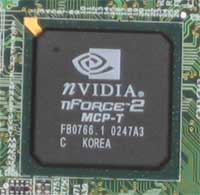 nVidia nForce2 MCP-T |
 Realtek RTL8201BL 10/100Mbit |
MCP-T also has
support for firewire which EPoX also has used with a circuit from Realtek.
The circuit offers two firewire-ports which are connected to the included
panel. EPoX 8RDA+ is even equipped with what we would call an underestimated
feature, trouble-shooting LED. It’s about a two digit display which shows
different number and letter combinations during the booting process. If there
is anything wrong it is easier to find what the problem is with the help of
the combination. We saw an external model of this on the CBox2-unit which
was sent with Chaintech 7NJS Zenith. Even if this is a feature which might
not be used very often it can be very useful when problems actually arise.
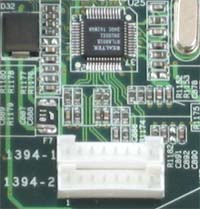 Realtek RTL8801B PHY (FireWire) |
 trouble-shooting LED |
Even if EPoX
8RDA+ might not impress with a lot features we think that what is offered
clearly is good enough. The accessories you get with the card are more or
less what is needed to use the card, device drivers and several small programs.
To lighten up the software package you also get two full version titles which
are more or less useful. The included panels gives the user access to both
extra USB2.0 and firewire ports which is very good considering that these
two interfaces are only getting more and more popular.
If we look at the integrated features the card offers the powerful sound processor
is the one to extinguish itself. The nForce2 APU is one of the most powerful
on the market, but the sound codec which is used from Realtek could prove
to be a bit of a bottleneck. This combination however is quite usual on today’s
nForce2 motherboards (nForce2 APU + Realtek ALC650).
As we said earlier EPoX 8RDA+ does not use the support for both Ethernet controllers
that exists in the nForce2 MCP-T. But most users manage without two Ethernet-controllers
and then the lone Realtek-controller is good enough. The integrated trouble-shooting
LED is a small bonus which we hope to become standard on motherboards within
a close future.
The biggest disadvantage with EPoX 8RDA+ if we look at features is the small
number of IDE-channels which the motherboard offers. As the card is neither
equipped with any ATA133 RAID-controller nor SATA-controller you can only
use four IDE-units before you have to purchase external controller cards.
Today it isn’t unusual to have more than one harddrive, CDRW and DVD-rom which
quickly makes use of all theses IDE-units.
Other than that, there are no direct flaws we can find, but there had been
room for a "Deluxe-model" in EPoX’s sortiment to push in some more
accessories and features.
|
Accessories/Features
|
||
| We look at the amount and usefulness for included accessories and integrated features. |
|
|
EPoX
is one of the few manufacturers who still stick to the old classical scheme
of colors which once was used by most manufacturers. Even if I personally
think that the colors are a bit boring, that won’t be anything that effects
the outcome of this review. After all, it’s just a matter of taste. 😉
A very positive
aspect of the EPoX 8RDA+ is the big space around the socket. This is never
a problem on Intel-systems as Intel’s special attachment device are included
in their chipset specifications and in that way is used by all manufactured
motherboards. On AMD-systems it is however worse since the manufacturers themselves
control the design of the motherboard. On EPoX 8RDA+ there is a lot of free
space around the base which enables the user to install really big heatsinks
like for example Alpha PAL8045. On a motherboard which directs itself towards
the enthusiast market this is a very important detail which EPoX hasn’t missed.
The chipset cooler on the motherboard is of a bit unusual design and of a
passive kind which unfortunately proved to have a multiple number of flaws.
|
|
We made some
quick tests with EPoX 8RDA+ when it showed up in the test lab and especially
during our overclocking tests the passive chipset cooler proved to become
very hot. After only a couple of minutes mild usage at high FSB-speeds (190MHz+)
the cooler became really warm. Even during original clock-frequencies the
cooler got very hot which shows that the nForce2 SPP chip generates quite
a lot of heat.
After we discovered this we determined to take a closer look at the cooler.
And it wasn’t a pretty sight that met our eyes as we dismounted the chipset
cooler. EPoX does not use thermal paste to transfer the heat to the heatsink,
but instead double stitched TIM (Thermal Insulating Material). Honestly speaking
we got surprised over the fact that any heat at all could be conducted with
such a bad contact surface. We cleaned the chip and the cooler with some alcohol
and applied some thermal paste instead. This is actually something we recommend
all owners of EPoX 8RDA+ to do, especially if you’re planning on running high
FSB-speeds. Then it might even be best to change the whole cooler to a more
efficient one.
|
|
Unfortunately
we see that EPoX hasn’t found any optimal localization for the ATX contact
which forces the ATX cable to be pulled around the processor cooler in the
case. This can both stop the air flow and be in the way of other things in
the case. The motherboard has three memory slots which together give support
for up to 3GB DDR400-memory. Memory slot three (furthest away from the CPU
socket) has it’s own memory controller while memory slot one and two share
a controller. For DualDDR to be activated there must always be a memory module
installed in dimm slot three.
On several motherboards, we have seen the memory slots being placed way to
closely to the AGP-port which has made the changing of memory very difficult
when a long AGP-card is installed. Unfortunately we have to admit that EPoX
8RDA+ is the worst motherboard in this aspect we have ever seen. When we installed
our video card on the motherboard it was almost as if the attachment hooks
scratched the back of the card. Our test system uses an Albatron Ti4200 video
card which is one of the longer ones in it’s class (almost the same size as
Ti4600) so users with shorter cards might make it without problems.
We have actually heard reports of users who during the installation of their
Ti4600 video card scratched of a circuit which then killed the card. This
is of course unacceptable and everyone who have a long AGP card should be
very careful during installation. And with the video card installed it is
impossible to change memory module if you do not physically bend the video
card which we, of obvious reasons, do not recommend. This is big mistake by
EPoX and we hope that this is only an isolated phenomenon.
|
|
On the I/O-panel
we see four USB2.0-ports, RJ45-contakt (LAN) and the other connections we
are used to. Unfortunately EPoX offers no digital sound output which makes
it impossible to use the Dolby Digital support for the card. Even if the motherboard
didn’t have to be equipped with more sound connections we had been glad to
se a possibility for this with, for example, external cables/panels. The motherboard
is equipped with six PCI-slots which is the maximum we’ve se on motherboards
these days, so there is nothing to complain about in that aspect. The IDE-connections,
trouble-shooting LED and CMOS-jumper are a few of the things we find on the
lower side of the motherboard.
|
|
EPoX 8RDA+ does
not have especially many drawbacks considering layout and design. The problem
is that there is at least one big disadvantage. We are of course speaking
of the problem caused by the lack of space for AGP and memory. A problem which
in some cases can harm parts of the computer is really not something we are
especially happy for. The positive is however that it doesn’t effect all systems
as the card that seems to take the worst beating is the nVidia GeForce4 Ti4600.
So all owners of Ti4600 should be very careful while installing their video
cards on EPoX 8RDA+.
Another smaller disadvantage is the weak chipset cooler. For those who use
the motherboard at it’s default speeds there shouldn’t be any greater problem
but since the card is directed to the enthusiast market we had expected a
better solution. We recommend that you at least equip the cooler with a small
fan if you consider using high FSB-speeds. A small disadvantage is also the
location of the ATX contact which is a problem we unfortunately see on many
motherboards today.
The positive aspects of the board is the large space around the socket, the
six PCI-slots and the four USB2.0-ports directly on the motherboard.
|
Motherboard
layout/design |
||
| We have considered the physical but also the esthetical aspects of the card’s design. User-friendliness is also an important factor. |
|
|
EPoX 8RDA+ is
equipped with a Phoenix-based BIOS and as usually EPoX has been good at implementing
many settings in the BIOS to satisfy the most demanding users.
Advanced chipset features is the menu most often used as it is the one with
the most interesting settings. Here you have the possibility to set everything
from FSB speed to AGP frequency. The nForce2 chipset has very generous memory
settings which enables you to optimize the system very well no matter how
good the quality of the memory is. What’s in the integrated features menu
isn’t very hard to understand. Here you have the possibility to disable and
activate the integrated features on the motherboard and make some general
settings for the system.
|
|
PC Health is
the built-in monitoring software which keeps an eye on temperature, voltage
and rpm of the system fans. There is also the possibility to get this information
shown during boot sequence which can be a good assistance. Power Bios is the
menu which together with Advanced chipset features stand for the overclocking
possibilities of the motherboard. In power bios you handle the voltage to
CPU, AGP and memory which we will look closer at soon.
EPoX has for
as long as I can remember been one of the manufacturers who encourage overclocking,
perhaps not officially but without a doubt if you look at how their products
are designed. EPoX 8RDA+ is really no exception and there are many overclocking
possibilities on this motherboard which we will show later on.
Unlike Chaintech 7NJS Zenith which didn’t offer higher FSB speeds than 200MHz,
EPoX doesn’t reach it’s limit until 250MHz (1MHz intervals). That was not
the case when the board was released, but in later bios versions 250MHz FSB
is enabled. The bios version which we had on our test example had support
for 250MHz FSB from the start. This will be enough for the most demanding
overclockers and to get close to these high FSB frequency’s you without a
doubt will have to modify the card physically. EPoX 8RDA+ offers just like
Chaintech 7NJS Zenith a great number of settings for adjusting the memory
speed (the picture doesn’t show it but it’s also possible to lower the memory
speed by 50 %). For those who use the nForce2 chipsets DualDDR support the
100% setting is the only thing that will do, asynchronous speeds only give
worse performance.
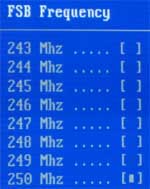
|
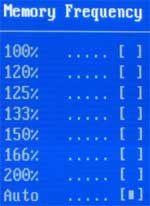 |
Power bios also
gives the user the opportunity to change the voltage for parts of the motherboard,
which is very important for serious overclocking. We have gathered the settings
here in a chart below.
| CPU-current: |
1.40v – 2.20v (0.025V intervals)
|
| DIMM-current: |
2.5v,
2.63v, 2.77v, 2.90v |
| AGP-current: |
1.5v
– 1.8v (0.1V intervals) |
The CPU-voltage
is increasable to 2.2v which is very good and actually a tiny bit higher than
what Chaintech 7NJS Zenith allows (2.15v). DIMM and the AGP voltage is a small
disappointment however if we compare with Chaintech 7NJS Zenith. The DIMM
voltage can "only" be increased to 2.9v and unfortunately not in
0.1v intervals either (Chaintech, maximum 3.2v). Even the AGP-voltage is a
bit lower than what Chaintech allowed but that’s not quite an equally big
loss. Not EPoX nor Chaintech allow changes of the voltage to the chip which
we can understand, considering the already large generation of heat. But higher
chipset voltage seems to be the key to high FSB frequency’s on the nForce2
chipset.
EPoX 8RDA+ has a good bios with a lot of nice settings. There are no revolutionizing
settings but we can’t really think of anything that’s missing. The possibilities
to overclock are very good, but unfortunately there is also a setback here.
The voltage settings for DIMM and AGP are not as impressive as on the card
from Chaintech, which we think is too bad. Perhaps this only effects the serious
overclockers, but still it is worth mentioning.
|
Bios/Settings
|
||
| We look at the design of BIOS and it’s settings, both for regular use and overclocking. |
|
|
|
Test
systems |
|
|
NVIDIA
nForce2 |
|
| Processor: |
AMD
Athlon XP 2100+ (266MHz) |
| Motherboard: |
EPoX
8RDA+ |
|
RAM:
|
2
x 256MB Corsair TWINX3200 |
|
VIA
KT400 |
|
| Processor: |
AMD
Athlon XP 2100+ (266MHz) |
| Motherboard: |
Soyo
KT400 Dragon Ultra |
|
RAM:
|
2
x 256MB Corsair TWINX3200 |
|
Other
hardware which was used in all testing systems |
|
|
Video
card: |
Albatron
GeForce 4 Ti4200 128MB @ 270/570MHz |
|
Harddrive:
|
46.1GB
IBM 75GXP |
|
Software
|
|
| Operating system: |
Windows
XP Professional SP1 |
| Solution: |
1280x1024x32bit,
85Hz |
| Device drivers : |
Detonator
v40.72 DirectX 8.1 NVIDIA nForce2 v2.00 VIA Hyperion 4in1 v4.45 |
|
Testing
programs : |
Quake
3:Arena v1.32 Unreal Tournament 2003 demo v.1080 3Dmark2001 SE 330 Comanche 4 SPECviewperf 7.0 Winace v2.20 Audioactive Production Studio 2.04j (Fraunhofer II encoder) SiSoft Sandra 2003 WCPUID |
We have made
some changes in the test system since the review of Chaintech 7NJS Zenith
and therefore we do not use the results from that board in the tests. Even
if we did some changes in our test programs too, our order of operation remains
the same. Before the performance tests in this review we experimented a bit
extra with memory timing and especially tested some with 4-2-2-2 settings
instead of the usual 5-2-2-2. However we couldn’t see any direct differences
between the two settings so in this review we have also used 5-2-2-2-timings
on both the nForce2 and the KT400 board.
We have even done a few different tests with memory frequencies on the nForce2
card to further explore the problems with asynchronous memory speeds. First
of all we have run the tests in the recommended setting where the memory bus
is synchronized with the FSB. We have used this setting both with single channel
(SC) and double channel DDR (DR). We have also tested the system with asynchronous
bus speeds on CPU and memory. This setting was made in DDR400-speed which
can be seen below.
|
Memory
speeds |
|
| DC266 |
133MHz
FSB, 2 x DDR266 |
| SC266 |
133MHz
FSB, 1 x DDR266 |
| SC400 |
133MHz
FSB, 1 x DDR400 |
The
tests on the KT400-motherboard have all been done with DDR333 memory speeds
and 5-2-2-2-timings.
Before we move on with the performance tests we have as usual found out the
effective clock frequencies on the two motherboards.
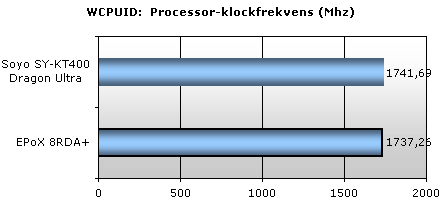
Soyo
KT400 Dragon Ultra has a minimal advantage compared to EPoX 8RDA+ but that’s
nothing that will effect the results of the tests.
In
our earlier motherboard reviews we have used both SiSoft Sandra and Cachemem
but after the big problems we’ve had with Cachemem we have decided only to
use SiSoft Sandra. To give a better picture of the memory bandwidth of the
motherboard we have instead used two memory tests in SiSoft Sandra. The two
tests are Buffered Memory Bandwidth and Unbuffered Memory Bandwidth
and here below a short explanation follows about what the difference
between the two is.
Buffered memory benchmark is the test which is default in SiSoft Sandra 2003
and includes different instruction optimizations and depends more or less
only on the memory frequency. The frame below has in default mode all the
squares filled in, but if you uncheck the squares as shown below the test
is free from all SSE/SSE2-optimizations etc. so even the timing of the memory
does a lot for the performance. This is called ‘unbuffered’ and is a better
indication of the real performance of the system.
We
start with the Buffered Memory Bandwidth test.
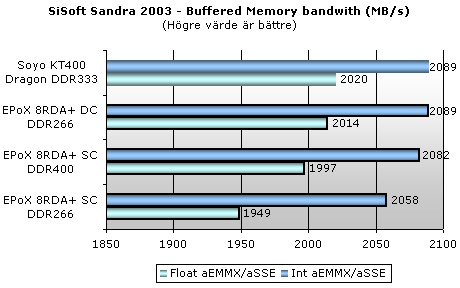
Here
we see that Soyo KT400 Dragon Ultra actually draws the longest straw, even
if it only wins by the least possible margin. According to the memory bandwidth
EPoX 8RDA+ doesn’t have any bigger problems with asynchronous speeds in SC-mode
while the memory bandwidth in the DDR400-system is marginally better than
on the DDR266-system. Despite it’s massive memory bandwidth the Dual DDR-system
can not take the lead in this test and the reason is simply the processor
bus which is a real bottleneck for the system. Let’s continue with the
Unbuffered Memory Bandwidth.
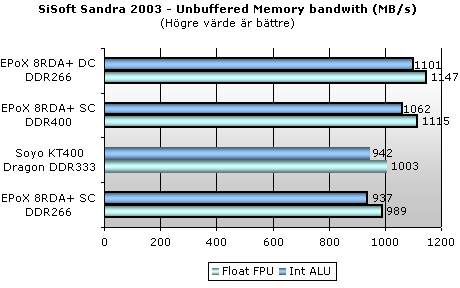
Here
we see an interesting turning point for the EPoX card which delivers impressive
bandwidth even compared to the well performing KT400 card from Soyo. Only
the SC DDR266-system can get past Soyo KT400 Dragon Ultra in this test and
the SC DDR400-system still tags along very well.
File
compression is one of the more usual jobs the computer gets to carry out and
it is a very memory demanding application.
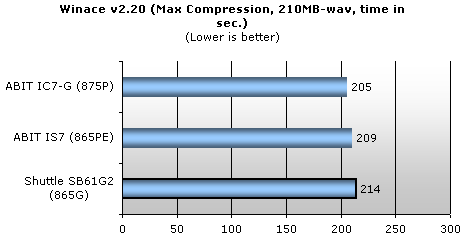
Here
it’s not only about memory bandwidth but also much about latency. The problems
with asynchronous bus speeds between memory and processor has often been related
to latency problems which our tests strengthen. Apart from the fact that EPoX
8RDA+ with DualDDR266 is equal to Soyo KT400, we see that the SC DDR400-system
for the first time gets behind the SC DDR266-system despite it’s massive overweight
in memory bandwidth.
| Audioactive Production Studio v2.04j – MP3 encoding (Fraunhofer II codec) |
We
have switched our testing program for MP3-encodning and now use Audioactive
Production Studio which is based on the Fraunhofer II-codec, a very demanding
codec which after all gives a good result.
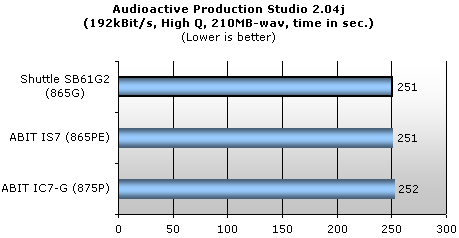
MP3-encodning
is in a very large extent depending on the CPU which we clearly see in the
results. In spite of the fact that the tests went on for almost five minutes
not even a second differs between the different configurations.
There
has also been a change in our game tests and that is the elimination of Jedi
Knight 2 that isn’t included among the tests. Since JK2 and Quake3 use the
same graphics engine the differences between the systems get more or less
unimportant, only the numbers differ.
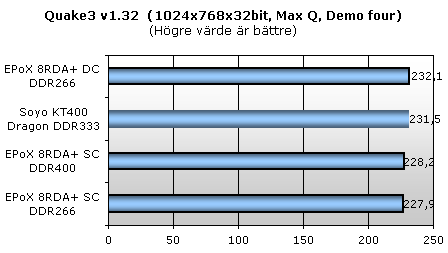
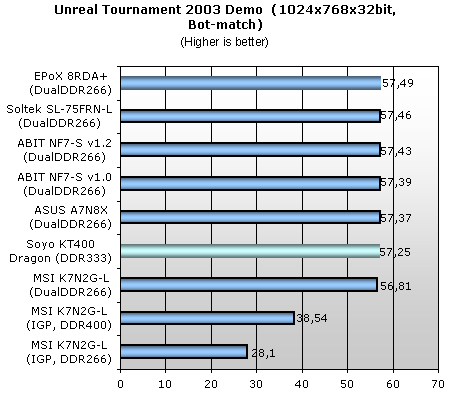
EPoX
8RDA+ with DualDDR266 takes the lead in the two gaming tests but the differences
are not big. Here we once again see that the SC DDR400-system has big problems
with the SC DDR266-system in spite of the big advantage in memory bandwidth.
| 3D demos – Comanche 4, 3Dmark2001 SE 330 |
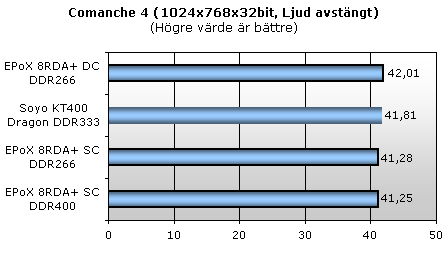
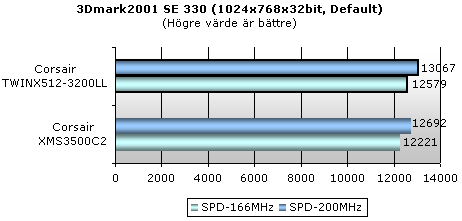
The
pattern is the same as in the earlier tests except for the fact that Soyo
KT400 Dragon Ultra seems to have grasped the longest straw. We can only give
VIA credit for their superb job with the new 4in1 device drivers, Hyperion
v4.45. Without these device drivers Soyo KT400 Dragon Ultra would probably
do far worse in the 3D-tests. The nForce2 chipset has obviously great potential
and we believe that there is even more performance to collect from this chipset.
Before we end our performance tests we would like to take a closer look at
the more advanced 3D-tests in SPECViewperf 7.0.
Also
in this review we have used some more advanced tests to get a good overview
of different workstation applications and we have used SPECviewperf 7.0
which we think fulfills the purpose perfectly. SPECviewperf 7.0 is a testing
application which contains six 3D-renderers from six different programs
on the market today. The six tests/programs are the following:
|
|
||
|
|
||
|
|
||
|
|
||
|
|
||
|
|
These
tests are run in window and could therefore be effected by the desktop’s
resolution. During our tests we used a solution of 1280x1024x32bits and
an update frequency of 85Hz.
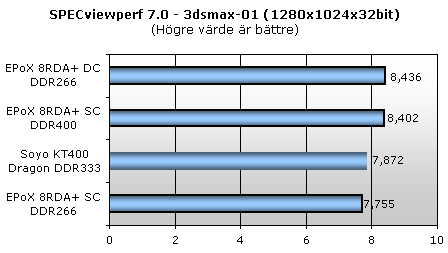
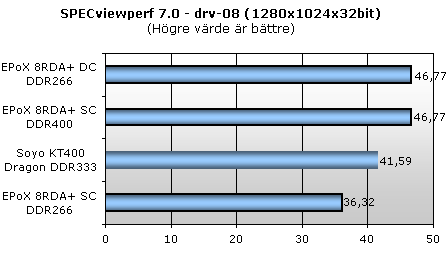
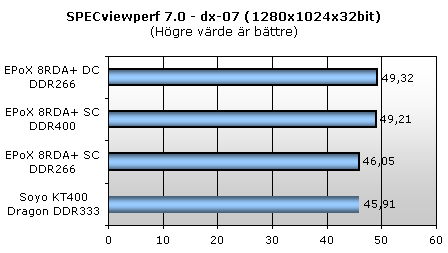
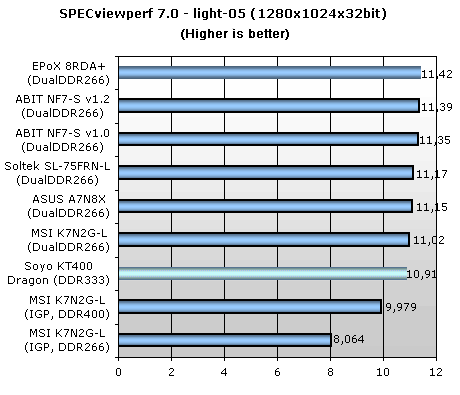
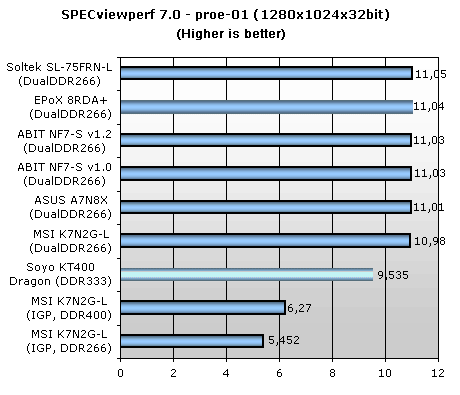
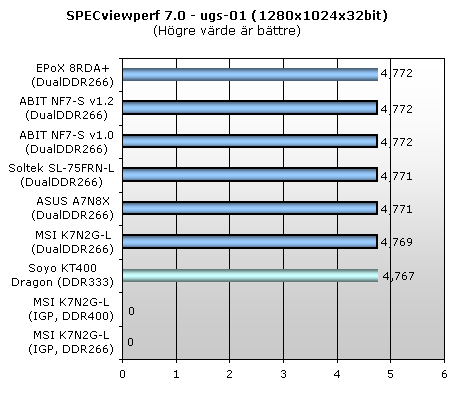
We
believe that nVidia has some work ahead of itself when it comes to gaming
and office performance, but when we look at advanced 3D-performance there
is only one king. The SPECviewperf tests show that NVIDIA has succeeded
very well in optimizing the workstation performance on nForce2. Soyo KT400
Dragon Ultra is in spite of the well developed 4in1 device drivers clearly
beaten and in some tests it can’t even win against the nForce2 card with
SC DDR266. SPECviewperf is also the only "realistic" test which
gives an big advantage to the DDR400-system in spite of the asynchronous
speeds. We can also say that we tested the system with DualDDR400 which
gave worse results than DualDDR266 in most of the tests.
After
thorough performance tests we can come to many conclusions. First of all
we look at the performance during single channel. Even if asynchronous
bus speeds sometimes can be an advantage which our tests show, often it
doesn’t make any larger differences. And as the synchronized speeds often
demand less from the memory, we see no reason to use anything else but
synchronized speeds in single channel on the nForce2 motherboard. The
same thing goes for DualDDR but here the advantages are even greater with
the synchronized speeds. The conclusion is that the nForce2 chipset clearly
works best with synchronized bus speeds whether the DualDDR-support is
used or not.
The performance delivered by the nForce2 chipset and EPoX 8RDA+ is nothing
but impressive at DualDDR and even if VIA manages to save it’s pride to
some extent with their new 4in1-device driver there is no doubt about
which manufacturer makes the best performing AMD-chip. Especially the
unbuffered test in SiSoft Sandra 2003 and the performance in SPECviewperf
shows the enormous potential of the nForce2-chip.
However we believe that nVidia or the motherboard manufacturers could
improve the performance a bit more on the nForce2 chipset but we are more
than pleased with the present performance.
|
Performance
|
||
| Thorough tests show how the performance of the motherboard is compared to competitive products on the market. |
|
|













